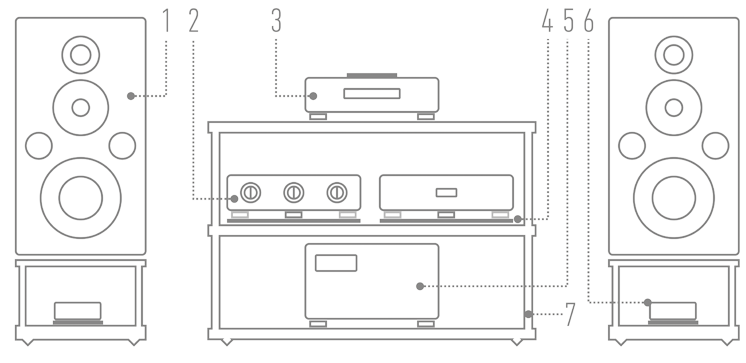|
Integrated amplifie Audio Reveal
Manufacturer: ALTRONIK |


|

|
| A few words about progress And its absurd lies in the fact that if we assume that there is constant progress in technology, such a situation should not happen. And it is the definition of the term 'progress' that is the key in this case. Its dictionary understanding is simple and unambiguous. Among the seven different applications provided by the Polish Dictionary of the Wydawnictwo Naukowe PWN, we are interested in three: 1 Progress in some discipline of science or other area of life is a sequence of changes taking place in it, bringing it closer to some goal or leading to more and more perfect states. Progress, as you can see, is clearly a positive word and concept. It leads from simple things, meaning inferior or worse, to complex, implicitly better ones. Progress in this approach is something good, desirable and awaited. What's more - it seems inevitable, something that will come, whether one likes it or not. Even if novelties seem to be worse and even dangerous for some people - see Luddites in England at the beginning of the industrial revolution, opponents of print from the fifteenth century, farmers in the Polish territories after World War II chasing away "economists", etc. - history proves that they were wrong. Because progress is by definition good (its implementation is usually worse, but this is a topic for a separate article). So where does the coexistence of audio products, which are separated by more than one technological revolution, billions of dollars invested, generations of scientists and engineers implementing them for production, come from? The answer seems to me to be simple, but only because I say it as someone who sees it from the inside, who feels how it works rather than understands it: progress in audio isn't linear and is arbitrary. Let me explain. One can probably assume that in audio we want the reproduced sound to be better and better, that is, more and more similar to a live performance. The problem is, that it's just an utopian idea, a beautiful fairy tale, but still a fairy tale. After all, one would have to be able to record the performance is a way identical with the event and then recreate it in the same way. I wrote about it many times that the recording, and then its reproduction is an art, not a mechanical translation. And if it is an art, then different approaches and styles are allowed, and so is their interpretation. | FIRST In audio, progress seems to be obvious, but at the same time doubtful - it gives are something, but it also takes a lot away. The more so because we are talking about music, which is a kind of art that is filled with emotions. And if these emotions are properly conveyed from the recording to the listener, we can talk about a success. And it does not matter at all how we achieve that - using tubes, transistors, applications, cables or wirelessly. That is why all these anachronisms exist side by side, often within one audio system. Mr Michał Posiewka when establishing the Reveal Audio company probably assumed the same, because when building an amplifier he decided to use tubes in the output, in the oldest known system - single-ended. He named his amplifier the First, as it was his first commercial design and additionally equipped with a feedback depth switch. That's the amplifier I would like to tell you about.  MICHAŁ POSIEWKA 
I am an electronics engineer and I have been running my company since 1989. From the beginning of its activity, it has been associated with the electronic industry. In the early years it was in a business of designing and serial production of alarm systems and access control systems. Later, the activity was extended to include installation services. The idea for designing tube amplifiers arose from many years of my passion for high class sound. In 2016, I decided to design a tube amplifier that would have its own sonic signature - that's how the Audio Reveal brand came to be. The development and production implementation of the first amplifier took about two years. This is time-consuming process, since designing an audio amplifier so that it offers high-level performance requires a lot of work – choosing tubes and their operating points, the right components, the multiple measurements, and last but not least many hours of listening in various configurations. 
The amplifying circuit in the tested device is very simple. It features four stages based on three tubes: input dual triode 12AX7 (ECC83), 12AU7 - the next dual triode, this time operating as a driver and a single beam (or kinkless, hence “K” in the symbol of KT88) tetrode, often confused with the pentode, the KT88, which can be replaced with 6550. The output tube works as pentode. The signal is amplified in class A from the input to the output, in a single-ended circuit, where the signal is amplified entirely in a single amplifying element, without dividing it into halves. A single tube in the output, truly single, not several working in parallel, usually means low power. Using a KT88 results in an output of 10 W at 8 Ω and 8 W at 4 Ω. So one should consider using loudspeakers of above average sensitivity. My Harbeth M40.1 are not particularly sensitive, but when driven by amplifiers with good current efficiency, they usually deliver good performance. The designer allow users to adjust the sound to individual taste using flip switch on the top of the amplifier, which changes the depth of global feedback loop. Remember, however, that you can't cheat physics meaning that when you lower feedback at the same time you increase distortion, narrow the frequency response down. There is also an advantage as by doing so one minimizes distortions resulting from providing a part of the output signal to the input. Usually, this is a choice of people who listen to the music. Because lower feedback (NFB: Negative Feedback) means usually a more pleasant, more natural sound. Tube amplifiers offer their users a unique opportunity to experiment with different tubes (so called: tube rolling). Although they carry the same symbols, they differ - and in a great way – from one another with their design and parameters, and hence with performance. A responsible manufacturer must, however, take care of the repeatability and reliability of the device, which is why the tested amplifier is delivered with reliable tubes, usually from current production. In the input one finds the 12AU7W by Tung-Sol from 1989, so actually a NOS tube. The driver 12AX7 comes from the same brand but is a most recent product. And last but not least, a power tube – it's a KT88 from Genalex Gold Lion. They were all made in Russia. The designer decided to use a soft start power up sequence with a delayed anode switching to extend tube's life span. Besides, tube amplifiers are not as prone to problems as many laymen think they are. Properly used, with good tubes they behave like ordinary transistor amplifiers. With average usage of a few hours a day most likely a user will have to replace tubes only after w few years. The tubes used in the First are easily available and therefore inexpensive. In any case, after switching the amplifier on a red LED flashes and after 45 seconds it changes to green - and green means: "ready".  The Audio Reveal amplifier was placed on the top shelf of the Pagode Edition rack next to the Ayon Audio CD-35 HF Edition player, which served as a source. The signal between them was sent through the Crystal Cable Absolute Dream interconnect. The First was driving large Harbeth M40.1 speakers. As I mentioned, they are not easy to drive, but several SET amplifiers with an output of a little over 6W performed very well with them. The tested amplifier features a very large dual mono power supply, reasonable output, so it did well with my speakers - even really well. The amplifier was connected with speakers atypically, because this time I used Western Electric WE16GA NOS cables. I spent some time comparing the two positions of the feedback switch. Let me put it this way, I can understand those who will choose the lower value. It will result in a warmer sound with clearer, more distinct foreground. With my loudspeakers however, I definitely preferred the presentation with more feedback. The sound was nicer, richer, more resolving, and the bass was better controlled. However, the choice is yours and it depends on your tastes and systems.  Recordings used for the test (a selec- tion)

|

I talked a lot about the output of the First amp, but I did it for educational purposes. I didn't mean to discourage you, or mess with you, but to make you aware of a simple rule: audio is an organoleptic activity. This means that although they are governed by specific rules, the final results depend on a specific system and you have to verify everything yourself. 
„On paper" combining the tested amplifier with large, not easy to drive Harbeth speakers seems like a crazy idea, and the same goes for many other equally "risky" potential partners. And if we believed it it would be a big mistake. This amplifier is able to drive such speakers as easily a 100W amp, as long as, of course, one operates at reasonable volume levels. It began already with the first words of the man announcing the performance of Bill Evans with his band during The Montreux Jazz Festival in 1968. His characteristic French accent amuses me every time, especially when he calls the name of Eddie Gomez (double bass). In any case, this short announcement already showed me what later became the basis for playing all other albums: unprecedented volume of vocals and instruments. My point is that the sound was large, had proper momentum, depth, and completely filled the space between the speakers. This is an advantage of tube amplifiers, but not all of them, and not to such an extent – the First really sounds in the same way as expensive SET amplifiers, with 300B tubes in the output. It presents people of flesh and blood, live instruments and a huge space. So we do not have to listen to the little bells in the left channel and the creaking of the chair in the right - our attention is immediately drawn to the musical events re-created in front of us. The tested amplifier owes this to several features, but among them immediately and above all one will point to the dynamics and tonality. Dynamics is above average, simply excellent. Evans Trio, that I mentioned at the beginning are only three, rather quiet, instruments in a large room filled with people. Thus, the scale of the event was created primarily by something like a dense background, not the instruments themselves. These were large, clear, powerful, but they were not a decisive factor in creating this huge momentum. It was completely different with Jimmy Smith's album. It was a fantastic performance! - there was slam, power and density - these are not just three instruments anymore and the whole big-band of fifteen (!) wind instruments, backed by Smith's Hammonds, drums and double bass. It sounded great because it was rich, full and dense. The organs descended really low and this fast, strong attack of the brass were both surprising. 
It worked not only due to high dynamics, but also an extremely well-balanced sound. This also attracts attention from the very beginning. I've been waiting until now with this information to sort everything out, but if you started reading this test from this paragraph, nothing would happen (do you remember a novel a year older than Smith's album, by Julio Cortázar Hopscotch?). Because it is an amplifier that does not actually pretend to be a tube one. I'm talking about pretending, because a lot of new tube designs seem to imitate the stereotype of this type of devices, without using the actual advantages of tubes. The First delivers an open sound, with a strong, resonant top, so it's hard to call its performance „warm”. It does not promote vocals, so you can claim it focuses solely on the midrange. Finally, it is not rounded at the bottom, it does not offer a false density, which is often nothing other than muddying the bottom, so to speak. The First delivers a clear, powerful, meaty bass, which surprised me first with Smith's album and then with a beautiful, romantic Pantha Rhei album of the Rudź & Pauszek duo. When the display showed 4:20 in the first track suddenly a truly low bass entered, and the amplifier not only played it nicely, it took it straight on and played it without hesitation. Because this – take a note - it is a very versatile device. With equal commitment, it will play ambient music, light jazz, big-band and vocal music. Although its resolution might not quite be on level with SET amps, the tested amplifier offers a better bass control and better momentum than most of them. And still it does deliver plenty of information. It allows listener for a nice insight into the recording, for recognizing the tonal cues of individual details, reverbs. As in the Fly Me To The Moon track from the Frank Sinatra's Duets II, who sings along with Antonio Carlos Jobim. We can clearly hear that these were rather mature gentlemen singing, that it's more fun than 'own contribution' for them. But what a duo it is! I do not know if you have already seen the first season of the series titled The Kominsky Method on Netflix (Chuck Lorre, 2018). The First presented very similar duo to the one from the screen: two gentlemen, but ones who do not have to do anything anymore, but they still can do (almost) anything... Summary „Reveal” means „discover unveil” – it's the key quality of Audio Reveal amplifiers. The First will allow you to re-discover your music, to experience it from a new perspective, it's a product of our passion for a high quality sound. It's not just a sales pitch, there is truth to it, that I tried to describe for you in this test. The First offers an extremely satisfying performance. It does not build distant layers of the soundstage but rather focuses listener's attention on what is in front of him. Yet, this presentation is so interesting, intriguing and surprising that one never gets bored. It is capable of driving speakers that are considered "difficult", as long as one doesn't push the volume level to hard. And it will make you go back to the old recordings just to check how they sound with the First. And then you will start to feel an urge to buy more music. It's simply a high-end device Made in Poland. Highly recommended!  The First is an integrated, tube amplifier with a semiconductor power supply. It's big, heavy, but that's how tube amps usually are - large transformers add to significant weight - power and output ones. In the tested device, they were placed in a classic manner, that is behind the tubes, hidden in shielding housings, whereby the power transformer is a toroidal one; all of them were custom made by Mr. Ogonowski, according to the Audio Reveal specification. 
The housings, as well as the entire chassis, were finished with black powder varnish. Appearance, however, is actually determined by something else - a wooden decorative element, forming a front panel and a stainless steel plates with holes for tubes. Front and back | All this elements have been well known for years and the design is almost a classic. We know this look for example from the amplifiers by the Slovak company Canor (later Elgar), and even more so from products of the Italian company Unison Research. The First reminded me also the latter with its knobs and flanges around them - they are large and made of stainless steel. The left on turns the device on, the middle one adjusts the volume, and the right one is an input selector - there are four RCA pairs of inputs available. The sockets are placed on the rear panel. There one finds also two pairs of gold-plated loudspeaker posts – there are no separate ones for 8 and 4 Ω loads. There is one more small switch on the top of the amplifier – it allows user to change the negative feedback value. There are two values to choose from and the difference between them is 3,2 dB. Inside | The is a dual mono design. The input connectors for right and left channels are placed wide apart which is a good indicator of such design. The electronic circuit has been assembled on one large printed circuit board, which is accompanied by several smaller ones. The latter host input relays, as well as a logic circuit that delays turning the anode voltage on to extending tubes lifespan. The latter operate in Class A. The signal is first switched in relays and goes to the potentiometer on the front panel. After attenuation it enters the 12AX7's grid, where the first and second halves are connected in parallel. In turn, the halves of the 12AU7 tube, the driver, work as separate stages. The loudspeaker output is adapted to a 6 Ω load and it is not possible to order this amplifier with other taps. In promotional materials, manufacturer mentioned "high-end components" - and indeed, one can find those inside the First. These are some precise high-power resistors, also lot of polypropylene Wima capacitors, and a good quality potentiometer - a blue ALPS. Power supply is obviously an important part of the design. The large transformer has a double secondary winding, and hence each channel has a separate power supply. Nichicon's capacitors were used in it. The only thing I have my doubts about are long, really long interconnects that run from the inputs to the potentiometer on the front panel. But you can not have everything :) It is still a very nice design and clean, well-thought-through assembly. 
The amplifier features nice, aluminum feet with rubber rings on them. There is no remote control (!).  Technical specifications (according to manufacturer) Input and driver tubes: |

|
Reference system 2018 |
|
 1) Loudspeakers: HARBETH M40.1 |REVIEW| 2) Line preamplifier: AYON AUDIO Spheris III Linestage |REVIEW| 3) Super Audio CD Player: AYON AUDIO CD-35 HF Edition No. 01/50 |REVIEW| 4) Stands (loudspeakers): ACOUSTIC REVIVE (custom) |ABOUT| 5) Power amplifier: SOULUTION 710 6) Loudspeaker filter: SPEC REAL-SOUND PROCESSOR RSP-AZ9EX (prototype) |REVIEW| 7) Hi-Fi rack: FINITE ELEMENTE Pagode Edition |ABOUT| |
|

|
Cables Analog interconnect SACD Player - Line preamplifier: SILTECH Triple Crown (1 m) |ABOUT|Analog interconnect Line preamplifier - Power amplifier: ACOUSTIC REVIVE RCA-1.0 Absolute-FM (1 m) |REVIEW| Speaker cable: SILTECH Triple Crown (2.5 m) |ABOUT| |

|
AC Power Power cable | Mains Power Distribution Block - SACD Player: SILTECH Triple CrownPower (2 m) |ARTICLE| Power cable | Mains Power Distribution Block - Line preamplifier - ACOUSTIC REVIVE Power Reference Triple-C (2 m) |REVIEW| Power cable | Mains Power Distribution Block - Power amplifier - ACROLINK Mexcel 7N-PC9500 |ARTICLE| Power cable | Power Receptacle - Mains Power Distribution Block: ACROLINK Mexcel 7N-PC9500 (2 m) |ARTICLE| Power Receptacle: Acoustic Revive RTP-4eu ULTIMATE |REVIEW| Anti-vibration platform under Acoustic Revive RTP-4eu ULTIMATE: Asura QUALITY RECOVERY SYSTEM Level 1 |REVIEW| Power Supply Conditioner: Acoustic Revive RPC-1 |REVIEW| Power Supply Conditioner: Acoustic Revive RAS-14 Triple-C |REVIEW| Passive filter EMI/RFI: VERICTUM Block |REVIEW| |

|
Anti-vibration Speaker stands: ACOUSTIC REVIVE (custom)Hi-Fi rack: FINITE ELEMENTE Pagode Edition |ABOUT| Anti-vibration platforms: ACOUSTIC REVIVE RAF-48H |ARTICLE| Isolators: |

|
Analogue Phono preamplifier: Phono cartridges:
Clamp: PATHE WINGS Titanium PW-Ti 770 | Limited Edition Record mats:
|

|
Headphones Headphone amplifier: AYON AUDIO HA-3 |REVIEW|Headphones: Headphone Cables: Forza AudioWorks NOIR HYBRID HPC |
main page | archive | contact | kts
© 2009 HighFidelity, design by PikselStudio,
projektowanie stron www: Indecity







 f we looked at the large audio show through reason - let it be the Warsaw Audio Video Show - we would get an almost surreal impression of an anachronism that nobody notice. It is about a peaceful coexistence of techniques and technologies that often come from times separated by several decades, for example turntables and file players (streamers), cables and wireless communications, knobs and control applications, tube power supplies and SMPSs, tubes and integrated circuits, etc. And yet dealing with them on a daily basis, reading about them, listening to them somehow, we do not see the absurdity of this situation.
f we looked at the large audio show through reason - let it be the Warsaw Audio Video Show - we would get an almost surreal impression of an anachronism that nobody notice. It is about a peaceful coexistence of techniques and technologies that often come from times separated by several decades, for example turntables and file players (streamers), cables and wireless communications, knobs and control applications, tube power supplies and SMPSs, tubes and integrated circuits, etc. And yet dealing with them on a daily basis, reading about them, listening to them somehow, we do not see the absurdity of this situation. 













